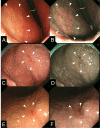Early gastric cancer detection in high-risk patients: a multicentre randomised controlled trial on the effect of second-generation narrow band imaging
- PMID: 32241898
- PMCID: PMC7788198
- DOI: 10.1136/gutjnl-2019-319631
Early gastric cancer detection in high-risk patients: a multicentre randomised controlled trial on the effect of second-generation narrow band imaging
Abstract
Objective: Early detection of gastric cancer has been the topic of major efforts in high prevalence areas. Whether advanced imaging methods, such as second-generation narrow band imaging (2G-NBI) can improve early detection, is unknown.
Design: This open-label, randomised, controlled tandem trial was conducted in 13 hospitals. Patients at increased risk for gastric cancer were randomly assigned to primary white light imaging (WLI) followed by secondary 2G-NBI (WLI group: n=2258) and primary 2G-NBI followed by secondary WLI (2G-NBI group: n=2265) performed by the same examiner. Suspected early gastric cancer (EGC) lesions in both groups were biopsied. Primary endpoint was the rate of EGC patients in the primary examination. The main secondary endpoint was the positive predictive value (PPV) for EGC in suspicious lesions detected (primary examination).
Results: EGCs were found in 44 (1.9%) and 53 (2.3%; p=0.412) patients in the WLI and 2G-NBI groups, respectively, during primary EGD. In a post hoc analysis, the overall rate of lesions detected at the second examination was 25% (n=36/145), with no significant differences between groups. PPV for EGC in suspicious lesions was 13.5% and 20.9% in the WLI (50/371 target lesions) and 2G-NBI groups (59/282 target lesions), respectively (p=0.015).
Conclusion: The overall sensitivity of primary endoscopy for the detection of EGC in high-risk patients was only 75% and should be improved. 2G-NBI did not increase EGC detection rate over conventional WLI. The impact of a slightly better PPV of 2G-NBI has to be evaluated further.
Trial registration number: UMIN000014503.
Keywords: endoscopy; gastric cancer; screening; surveillance.
© Author(s) (or their employer(s)) 2021. Re-use permitted under CC BY-NC. No commercial re-use. See rights and permissions. Published by BMJ.
Conflict of interest statement
Competing interests: MM received grants from Olympus during the study period. TY received personal fees and non-financial support from Olympus, outside this study.
Figures


Comment in
-
Incorrectly analysing stratified and minimised trials may lead to wrongfully rejecting superiority of interventions.Gut. 2022 May;71(5):1038-1039. doi: 10.1136/gutjnl-2021-324936. Epub 2021 Jul 14. Gut. 2022. PMID: 34261753 Free PMC article. No abstract available.
References
-
- Katai H, Ishikawa T, Akazawa K, et al. . Five-Year survival analysis of surgically resected gastric cancer cases in Japan: a retrospective analysis of more than 100,000 patients from the nationwide registry of the Japanese gastric cancer association (2001-2007). Gastric Cancer 2018;21:144–54. 10.1007/s10120-017-0716-7 - DOI - PubMed
